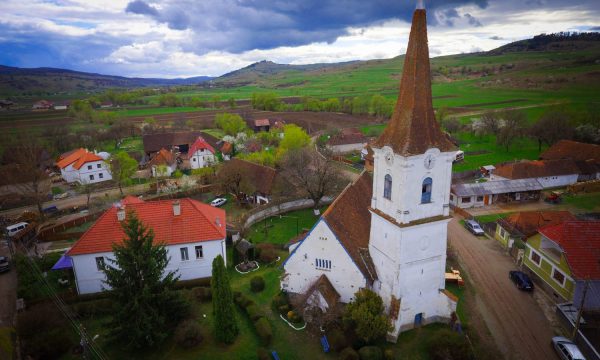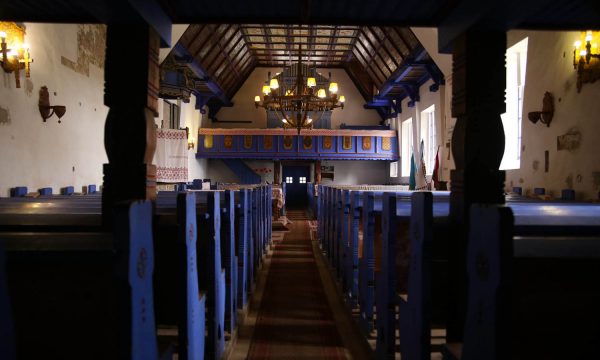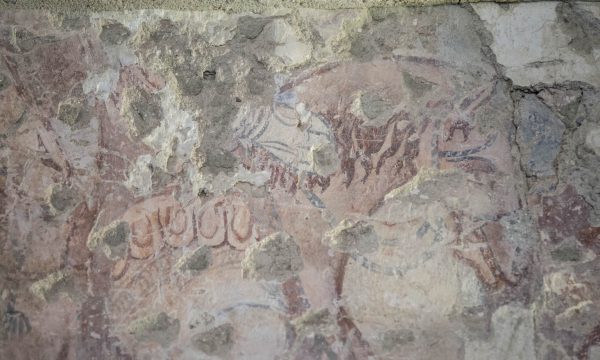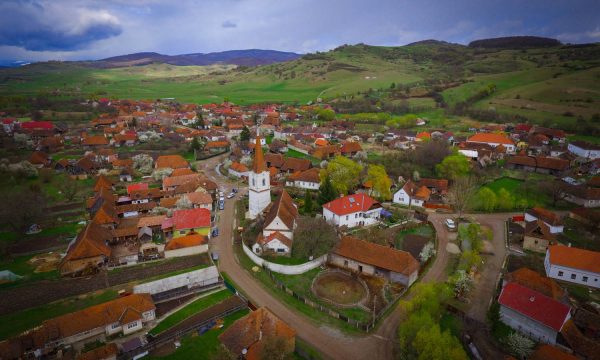Wall painting
The church in its present form has barely preserved anything from its medieval state. Originally, its layout might have been similar to that of the church in Crăciunel (Hu: Homoródkarácsonyfalva), except that its choir terminated presumably in a straight wall. Its major reconstruction probably took place at the turn of the 15th and 16th centuries, when a new choir was built in the width of the nave, terminating in three sides of an octagon.

During these works the cornice of the nave was raised approximately by a third of its height. The tower was probably also built at the same time. This was heightened in 1654 and in the 19th century. The demolished vault of its choir was replaced by a painted wooden ceiling at the end of the 18th century. However, its triumphal arch was demolished only in 1810. Its radical rebuilding took place in 1937, when only three walls of the nave and the separate tower remained. A new extension – a nursing home – was added to the church on the western side. These works were carried out based on László Debreczeni’s plans, who had new large windows cut in the southern wall of the nave. However, the wooden ceilings and painted pieces of furniture from the 18th and 19th centuries were preserved during these works. Only the pews were replaced by new ones.

During these works, medieval mural fragments were discovered while radically removing the plaster layers. Imre Kelemen, a minister revealed the murals with his own hands, which he then documented with photos and descriptions. Because of a conflict that took place at that time, the paintings were made to disappear, but we had no idea what happened to them. We didn’t know whether they were destroyed or simply plastered over.
Fortunately, thanks to pastor Kelemen’s thoughtfulness, they were only quickly covered with a plaster layer, so during our research in 2007 we found each and every mural fragment photographed by the clergyman. On the southern wall, the three-quarter life size figures of St. Peter and St. Paul were discovered in a richly ornamented frame, marked with an inscription written in minuscule. In the lower register of the southern wall, similarly to the church in Mugeni (Hu: Bögöz), a composition of the Last Judgement was found, with only its western section preserved in a relatively good condition. The angel blowing the trumpet, the figures of the apostles Peter and Paul were some of the best-preserved fragments. Above this, immediately under the former cornice the artist painted the legend of Saint Ladislaus. Unfortunately, this painting was also fragmentarily preserved. The story starts on the western wall just as in the case of the above-mentioned composition in Mugeni. Here you can see the large face of a saint standing next to a crenelated wall and a tower painted in perspective. It goes on in the northwestern corner with an angel crowning St. Ladislaus.

A similar scene has not been known in other representations of this legend. A hand stretched out from a stylized cloud placing a crown on the head of the holy king can only be seen in two scenes on the very damaged, worn painting in Ațel (Hu: Ecel). Above the Apostles we uncovered a figure on a horse that can be identified as St. Ladislaus. Based on his weapons and armour the murals can be dated to the middle or the second half of the 14th century. We discovered fragments close to its former triumphal arch that were much more damaged than the aforementioned ones, including a horse head and St. Ladislaus’ figure from the fight scene. Although its complete exploration has not taken place yet, it is already certain that the mid-section of the painting has been destroyed, and the details can be interpreted only from the two ends of the mural.
Natural Heritage
Ocland is a small village in the valley of the river Homorodul Mic (Hu: Kis-Homoród) surrounded by hills. The village lies in the heart of the Defileul Mureşului Inferior şi Dealurile Lipovei Natura 2000 special bird conservation site (ROSPA0029, HU: Homoródi-dombság különleges madárvédelmi terület). Each of these hills provides habitats for many protected and valuable species, such as the lesser spotted eagle (Aquila pomarina), red-backed shrike (Lanius collurio) or the corn crake (Crex crex).

If we leave for Merești (Hu: Homoródalmás), after going around a few hills, we can arrive to the site of the Vârghiș (Hu: Vargyas) river’s multi-millennial work. The fast flowing river has carved a picturesque gorge and a rich cave system into the limestone, creating the Cheile Vârghişului Natura 2000 site (ROSCI0036, Hu: Vargyas-szoros Natura 2000 terület). Almost all possible limestone canyon formations can be found here: karst springs, rock glaciers, lookouts, rock walls and cliffs, and also 125 caves, four of which can be visited, including the Transylvanian Region’s first scientifically explored and mapped cave, named after the famous Hungarian polymath, Balázs Orbán.
But the gorge is not only a showroom of these beautiful formations, it is also a home for many rare and protected creatures. The various habitats include the common alder (Alnus glutinosa) and ash (Fraxinus excelsior) groves, rocky grasslands, Lithophytes (plants growing in or on rocks), beech forests, ravines, and caves. 17 of Romania’s 34 bat species can be found in these caves, including the Alcathoe bat (Myotis alcathoe), which was first discovered in these caves in Romania, and the largest lesser horseshoe bat (Rhinolophus hipposideros) colony in the country.
Many rare and colourful plants can be observed in the gorge by walking the tourist trail in the summer months, the martagon lily (Lilium martagon), red helleborine (Cephalanthera rubra) and the Aconitum moldavica among them. The endemic Carpathian species living here include the wild garlic (Allium ursinum), heartleaf oxeye (Telekia speciosa) and the large blue hepatica (Hepatica transsilvanica). The many colourful dragon- and butterflies represent the area’s invertebrate population, which also includes the strictly protected Rosalia longicorn (Rosalia alpina).
